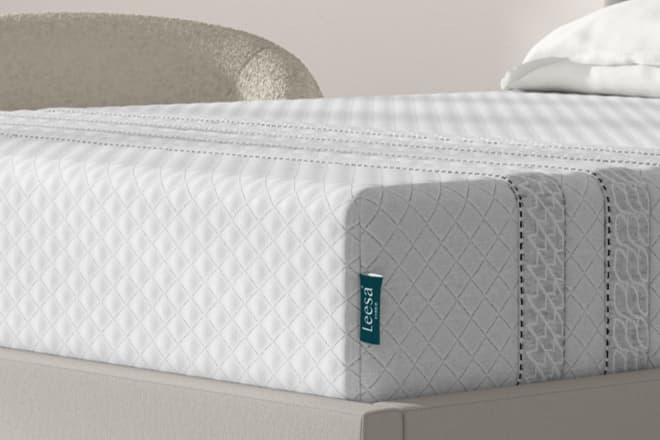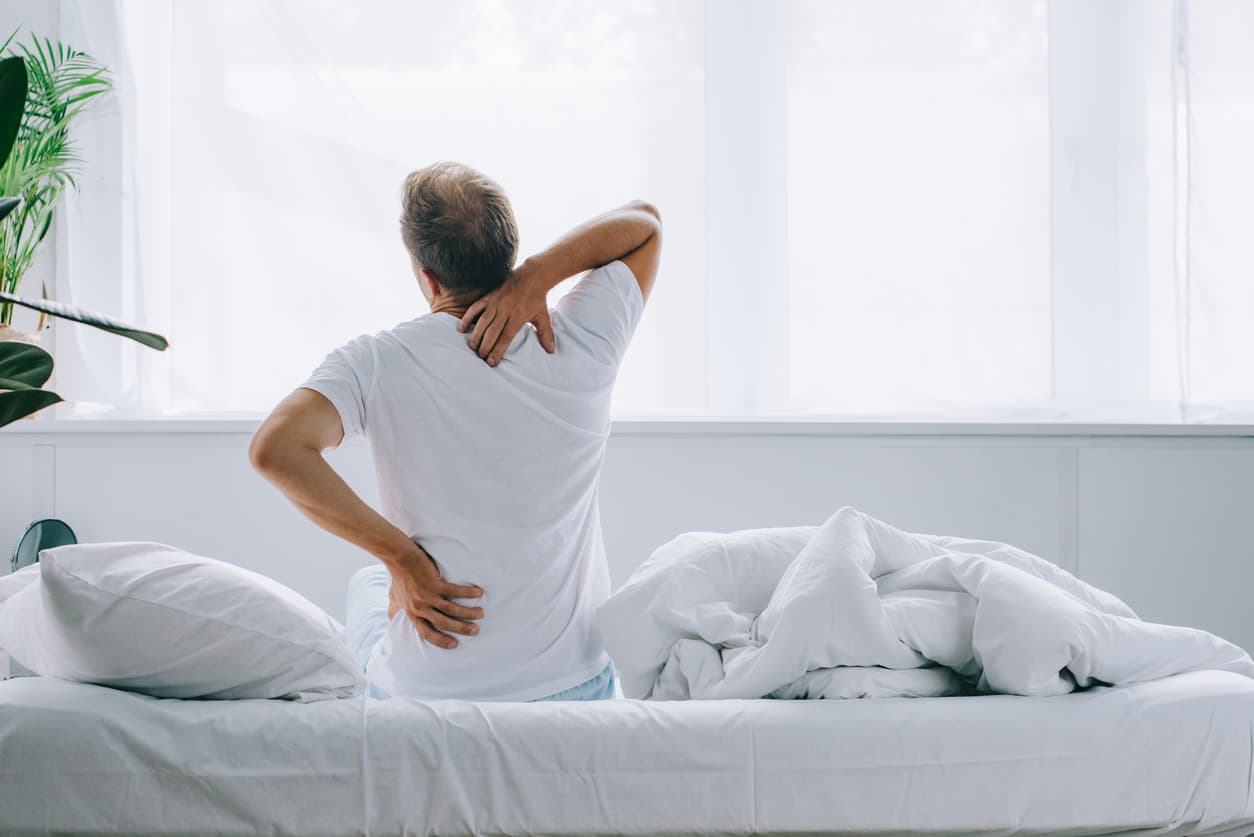Did you know only 10% of people prefer sleeping on their backs? Although it’s not the most popular sleep position, some medical experts believe that sleeping on your back can be extremely beneficial for reducing pain.
Everyone is different—from your favorite color to the foods you like, to your hobbies. So, when it comes to sleep, it's no surprise that people prefer different sleeping positions and sleep settings. Whether you're a side, stomach, or back sleeper, there is probably a certain sleeping position that you're most comfortable in.
Do you like to sleep with a pillow between your legs? Maybe you prefer sleeping with your arms and legs outstretched. No matter how you're most comfortable falling asleep, it all depends on your personal preference. However, there are notable benefits and reasons to learn how to sleep on your back.
Benefits of Sleeping on Your Back
From a purely mechanical perspective, learning how to sleep on your back comes with an array of benefits. Chief among them is that you can keep your spine aligned , avoiding many of the common aches and pains that come with otherwise fitful sleep. In addition, this alignment promotes good rest and healing across a variety of areas, including:
Less Pressure on Your Back
When you learn how to sleep on your back, your head, neck, and spine stay aligned in a neutral position, reducing pressure on those spots. This means the right way to sleep is on your back, with your weight as evenly distributed as possible. Evenly distributing your weight reduces pressure, meaning you wake up with less pain.
Helps Reduce Acid Reflux Symptoms
If you suffer from acid reflux, you should learn how to sleep on your back. This is especially true if you eat close to bedtime. If you properly support your head so it's elevated slightly above your stomach, you may be able to reduce acid reflux symptoms while you sleep. Reducing these symptoms means your head rests at an inverted angle, slightly diagonal to the rest of your body, and raised off the pillow.
Relieves Your Sinuses Naturally
Sleeping on your side or stomach may create additional sinus buildup and pressure—especially if you already struggle with sinus issues. Sleeping on your back with your head slightly elevated allows your sinuses to take advantage of gravity. This helps drain fluid that builds up, removing it from your nose and head. As a result, you'll wake up with less pressure and drainage.
Reduces the Frequency of Headaches
First, it's important to understand how headaches form. Many headaches,like cervicogenic headaches, often develop in the cervical spine. Proper spinal care, particularly when you sleep, is critical to managing headaches and reducing pain in general.
Sleeping on your back promotes an even distribution of weight, reducing muscle tension and ensuring that your body can rest in the most pain-free, natural position possible. As such, sleeping on your back promotes healthy spine alignment and can potentially reduce headaches .
Decrease the Visibility of Wrinkles
Do you ever wake up with sleep wrinkles on your face and body from your pillow, blanket, or hand? One of the lesser-known benefits of learning how to sleep on your back may be improved appearance of skin.
Believe it or not, experts have found that people who sleep on their side or stomach often have
deeper and more prominent facial wrinkles
. If you're consistent about sleeping on a specific side or on your stomach? A sleep expert or dermatologist may even be able to tell what side you favor just by looking at your skin.
How to Train Yourself to Sleep on Your Back
It can be hard to change your sleeping position, especially if you've been sleeping the same way for a long time. Therefore, you may have to do some sleep training to learn how to sleep on your back. Expect there to be an adjustment period when you intentionally change your sleeping position.
Many experts say it takes weeks or months to form a habit. This explains why it will likely take some time before figuring out exactly how to sleep on your back!
1. Start with a supportive mattress.
Different mattresses can impact sleepers differently, and it can be very difficult to learn how to sleep on your back without the right mattress. Therefore, if back sleeping is important to you and your health, you should consider updating your mattress. Ideally, one with a medium-firm feel that is ideal for back sleepers.

2. Use pillows under your knees and lower back.
Try putting a pillow or rolled-up towel under your knees to alleviate pressure on your spine and keep your spine aligned.
3. Create a barrier of pillows on either side of you.
This can prevent you from rolling over and help you feel more protected and secure while on your back. Try a pillow on either side of you to rest your arms on. This can help you feel cradled.
4. Lay flat on your bed.
Try lying down with your arms above your head in a goal post position or stretching them out straight on either side of you. If you sleep alone, you can even try the starfish position, pointing your arms and legs toward the corners of your mattress.
5. Elevate your upper body slightly.
You can elevate your body with an adjustable base or an incline of pillows. Doing so may provide additional comfort, particularly if you are used to sleeping in a different position. Furthermore, some evidence shows that sleeping with your head elevated may increase lung function and oxygen levels in the blood.
6. Relax with breathing techniques for stress relief.
Studies have found that breathing techniques may help with stress relief. Deep breathing has been found to slow the heart rate, reduce anxiety, and help bring peace.
Fortunately, you can try dozens of breathing techniques, including Belly Breathing, 4-7-8 Breathing, Box Breathing, and more. Finding a breathing technique that you are comfortable with may take some time. But with practice, breathing techniques can help you learn how to sleep on your back.
Back Sleeping Isn’t for Everyone
Just because back sleeping has many benefits, that doesn't mean it’s the right sleeping position for everyone. People who are pregnant or have health conditions like sleep apnea and heavy snoring should avoid back sleeping as it can pose health risks.
Fortunately, there are alternatives and modifications you can try. For example, you can try to sleep on your side. But with your legs stretched, allowing your spine to stretch out and remain as aligned as possible. Keeping a pillow between your knees can help with this process.
How Can Leesa Help?
When it comes to getting a good night's sleep, having the right mattress is key, no matter your preferred sleeping position. We understand that everyone is unique, with different body types and sleep preferences. That's why we take pride in offering a range of fantastic mattresses designed to cater to all body types and sleeping positions.
The bargain-priced Studio Mattress comes with three different layers of memory foam for pressure relief and support. Another affordable option is the Leesa Original, our all-foam mattress that now features enhanced pressure relief and cooling technology. Next, our Sapira Hybrid Mattress features premium foams and over 1,000 inner springs, offering edge-to-edge support and enhanced pressure relief. Finally, the Legend Hybrid Mattress is our top-of-the-line luxury mattress. It offers medium support and a 100% organic cotton Merino wool mattress cover.
Are you ransitioning to sleeping on your back, or if you're a side or stomach sleeper? Leesa mattresses will provide you with unprecedented comfort and support to give you your best sleep ever.



